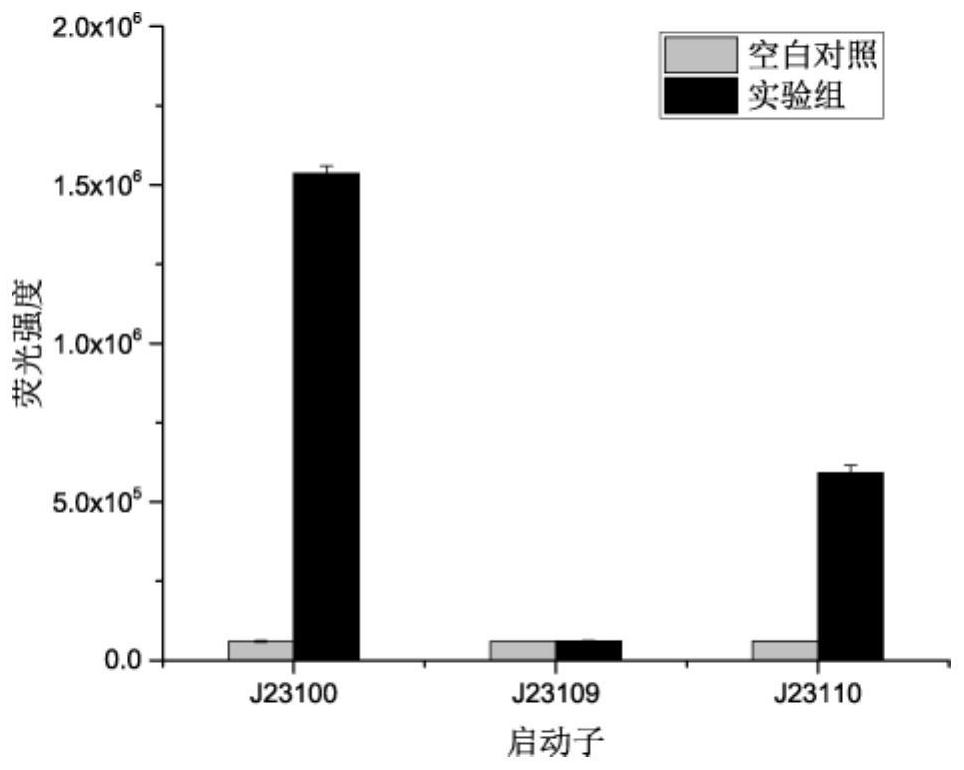D-psicose biosensor and application thereof
A technology of biosensor and psicose, which is applied in the field of synthetic biology and biochemical industry, can solve the problems of high equipment requirements, inability to real-time, low sensitivity, etc., achieve high-throughput screening, save time and labor costs
- Summary
- Abstract
- Description
- Claims
- Application Information
AI Technical Summary
Problems solved by technology
Method used
Image
Examples
Embodiment 1D
[0024] Example 1D-Construction of psicose biosensor
[0025] In this example, a DNA-encoded D-psicose biosensor will be constructed.
[0026] Both the transcription factor PsiR and the inducible promoter PsiA were derived from Agrobacterium tumefaciens. The coding gene PsiR of PsiR was optimized and synthesized by Sangon Bioengineering (Shanghai) Co., Ltd. (the optimized PsiR nucleotide sequence is shown in the sequence table SEQ ID NO.5), and cloned into the BamHI / HindIII digested vector pUC57 Between the sites, pUC57-PsiR was obtained; the promoter PsiA was synthesized by Sangon Bioengineering (Shanghai) Co., Ltd. (the nucleotide sequence of PsiA is shown in the sequence table SEQ ID NO.7), and cloned into the BglII of the vector pUC57 / XbaI restriction site, to obtain pUC57-PsiA.
[0027] The expression intensity of transcription factors is a key factor affecting the response range of biosensors. The present invention uses 3 promoters (J23100, J23109 and J23110) of diffe...
Embodiment 2
[0039] D-Psicose Biosensor Analysis
[0040] The above nine kinds of plasmids carrying biosensors were transformed into Escherichia coli BL21(DE3). After overnight activation, they were transferred to LB+Kan medium (Table 3) according to the inoculum size of 3% (v / v). After culturing at 37°C and 200 rpm for 3 hours, the expression of the reporter gene was induced by adding D-psicose at a final concentration of 100 g / L; the blank control was set without adding D-psicose under the same conditions. Under the conditions of 37° C. and 200 rpm, the culture was continued for 5 h. Cells were collected by centrifugation, washed with PBS of 50 mM PBS (pH=7), and resuspended in PBS. The fluorescent signal of the reporter gene EGFP and the biomass OD of the cells were measured by a multi-functional microplate reader (TECAN Infinite Plex). 600 . When measuring the fluorescence signal of EGFP, the excitation light and emission light were set to 488nm and 520nm, respectively. Set the in...
Embodiment 3
[0047] Dynamic range analysis of D-psicose by biosensor
[0048] In order to analyze the dynamic range of the biosensor for D-psicose, the present invention selects J23109-PsiR-T7PsiO-EGFP and J23109-PsiR-PsiA02-EGFP which have higher sensitivity to 1g / L D-psicose. The induction method is as in Example 2, adding D-psicose with a final concentration of 0, 0.2, 0.4, 0.6, 0.8, 1.0, 2.0, 3.0, 4.0, 5.0 g / L respectively, and measuring the fluorescence signal (excitation light and emission light) Light is 488nm and 520nm respectively) and biomass OD 600 , and use the pair OD 600 Normalize the fluorescent signal (A 520 / OD 600 ). The results showed that both J23109-PsiR-T7PsiO-EGFP and J23109-PsiR-PsiA02-EGFP responded to D-psicose within a certain range, and showed a substrate saturation effect after exceeding a certain range (results such as Figure 5 ). The dynamic range of J23109-PsiR-T7PsiO-EGFP is 0–4.0g / L D-psicose, and the dynamic range of J23109-PsiR-PsiA02-EGFP is 0–3....
PUM
 Login to View More
Login to View More Abstract
Description
Claims
Application Information
 Login to View More
Login to View More - R&D
- Intellectual Property
- Life Sciences
- Materials
- Tech Scout
- Unparalleled Data Quality
- Higher Quality Content
- 60% Fewer Hallucinations
Browse by: Latest US Patents, China's latest patents, Technical Efficacy Thesaurus, Application Domain, Technology Topic, Popular Technical Reports.
© 2025 PatSnap. All rights reserved.Legal|Privacy policy|Modern Slavery Act Transparency Statement|Sitemap|About US| Contact US: help@patsnap.com



